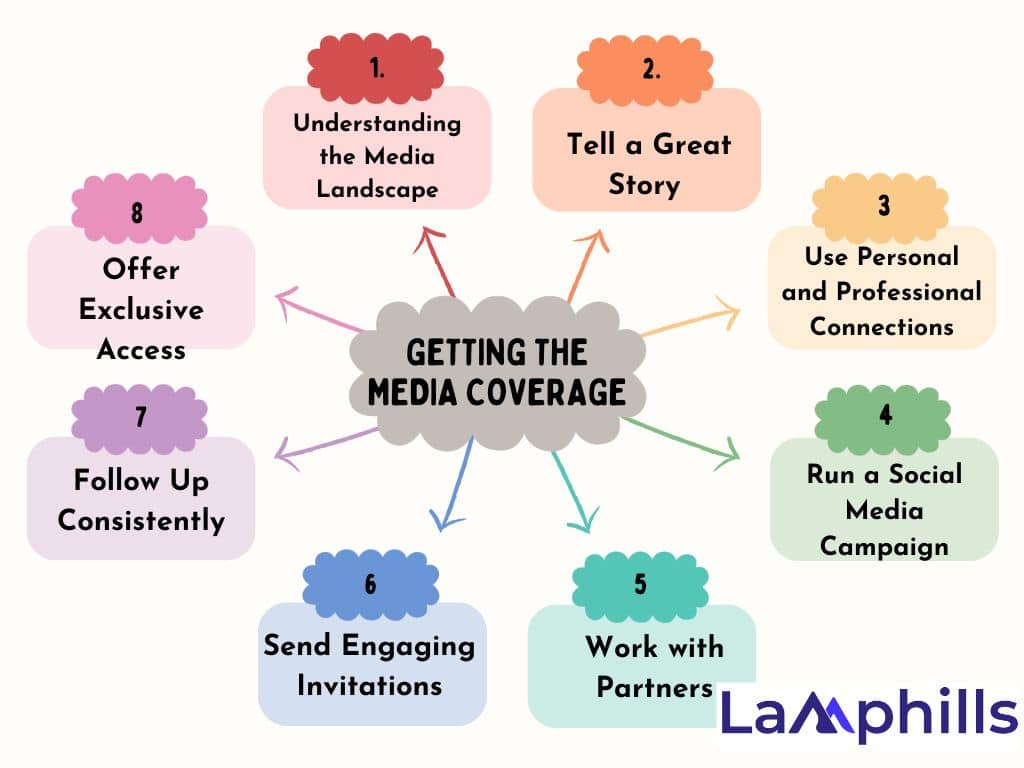If you want to learn how to get media coverage for your business or event, you’ve come to the right place. One of the main reasons for organizing events or starting a business is to attract attention and get people, including the media, to talk about it.
I remember the first time I got media coverage for a client. It was a busy Monday morning, and my phone was buzzing with excitement. My client, a local tech startup, had just launched a new app to help small businesses. They wanted media attention but couldn’t afford a big ad campaign.
As an experienced HR consultant and content writer, I took on the challenge. I wrote an engaging press release and sent it to several journalists. A week later, their app was featured in a major business magazine, leading to a big increase in downloads and new customers. This experience showed me the power of media coverage.
Since then, I’ve helped many businesses achieve similar results. Just last year, I took on a big challenge: planning my sister’s wedding and making sure it got lots of media attention. With my public relations experience, the results were amazing.
The wedding was a huge success. Everyone in town was talking about it, and all the media covered the event. There were a lot of people there, and the lively atmosphere made it a memorable day for everyone.
Here’s how I made it happen and how you can do the same for your business or event. First, let’s find out what media coverage is.
Key Points
- Media coverage is the time or space that media outlets like TV, newspapers, radio, and online platforms give to a specific event, issue, or person. It involves media sources reporting, documenting, or mentioning the event, issue, or individual, thus giving them exposure or visibility.
- Media coverage helps more people see your event or business. When journalists write about you, it reaches a wide audience through newspapers, TV, radio, and online platforms, making you more noticeable.
- One of the steps to get the media to cover your business or event is, “Know your Audience.”This can be challenging, but it’s important to know your audience and where they get their news.
What is Media Coverage?
Media coverage is the attention a person, brand, event, or topic gets in different types of media, like newspapers, TV, and online platforms. It includes news stories, interviews, features, reviews, and other content that focuses on the subject. Media coverage is important because it helps shape public opinion, build reputation, and increase awareness.
Read Also: How to Write a Media Pitch with Practical Examples & Templates
The benefits of media coverage for your events and business are very important. Here are a few examples.
Benefits of Media Coverage to Your Events and Business
#1. Increase Visibility
Media coverage helps more people see your event or business. When journalists write about you, it reaches a wide audience through newspapers, TV, radio, and online platforms, making you more noticeable.
When you invite the media to cover your event or business, you access their large audience. Media outlets like newspapers, TV channels, radio stations, and online platforms reach many people. For example, a news story about your event can be seen by thousands or even millions, greatly increasing your visibility.
#2. Build Credibility
Being featured in well-known media outlets boosts your credibility. People trust your brand more when they see it covered by reliable news sources, improving your reputation.
When a trusted journalist or news outlet covers your event, it shows the public that your event is important. This endorsement can make your brand more trustworthy.
#3. Attract More Attendees or Customers
Media coverage draws more people to your event or business. Well-covered events in the media can attract larger crowds. People often rely on the media for event and business recommendations. A positive story or review can encourage more people to attend your event or try your products and services.
#4. Generate Buzz and Excitement
Media coverage creates excitement around your event or business. A good news story can build anticipation and word-of-mouth promotion, leading to more interest and participation. This buzz can lead to more social media activity, event registrations, and sales, as people get excited to be part of something noteworthy.
#5. Showcase Your Expertise
Inviting the media lets you show your expertise and industry knowledge. Highlighting your achievements and unique offerings positions you as a leader in your field. For example, if your business has developed a new product, media coverage can show your expertise and the product’s benefits. This positions you as an industry leader and can attract clients and partners.
#6. Strengthen Community Connections
Engaging local media helps you connect with the community. It shows you care about the local area, which can foster goodwill and support from community members and local businesses. In addition, loyal customers who value your presence.
#7. Create Lasting Content
Media coverage provides high-quality content for your marketing. You can share articles, interviews, and news segments on your website, social media, and marketing materials, extending your message’s reach.
#8. Crisis Management
During a crisis or bad publicity, media coverage lets you explain the situation, clear up misunderstandings, and share your perspective. Using the media wisely can help protect and restore your reputation.
By inviting the media to cover your event and business, you can achieve these benefits and more, contributing to your growth and success.
The checklist below will help guide you to ensure comprehensive and effective media coverage
Let’s talk about how to get media coverage for your business or event. I’ll explain how I helped a client’s tech business and my sister’s wedding get media attention using these methods.
How to Get Media Coverage for Your Business & Event
#1. Understanding the Media Landscape
Getting media attention can be challenging, but it’s important to know your audience and where they get their news. For example, with tech startups, I focus on tech blogs, industry magazines, and social media influencers who discuss tech topics. Adjusting your approach based on your audience’s habits can greatly improve your chances of being noticed.
#2. Crafting a Newsworthy Story- Tell a Great Story
The key to getting media coverage is having an interesting story. When the tech startup launched its app, I focused on the specific problem it solved and included real stories from small business owners who benefited from it.
My sister’s wedding had it all: a cross-cultural romance, a tribute to family heritage, and a theme of unity and love. We focused on their journey, unique backgrounds, and the mix of traditions that made the wedding special.
This made the story more relatable and appealing to the media. Journalists want stories that connect with their readers, so find that special angle in your business or event that makes it unique.
#3. Create a Media Kit
A media kit is a collection of materials that showcase your event and make it easy for journalists and influencers to write about it. It should include a press release, a fact sheet, a logo, high-quality photos and videos, testimonials, and contact details. You can also add a media pitch, which is a short, engaging email that summarizes your event, explains why it’s important, and invites the recipient to learn more or attend. Make sure your media kit is available online and regularly updated.
Because this was important, I put together a detailed press release, high-quality photos, background info on the couple, and unique aspects of the wedding. This kit gave journalists everything they needed to write an engaging story.
#4. Use Personal and Professional Connections
Don’t wait until the last minute to contact the media. Begin building relationships with key journalists, bloggers, podcasters, and influencers well before your event. Follow them on social media, engage with their posts, share their content, and provide useful information. Find those who cover topics related to your event and have a large, active audience. Then, personalize your pitch to them, explaining why your event is relevant to their niche and audience.
As for me, using my network was crucial. Over the years, I have built strong ties with local journalists and media outlets. I reached out to them, pitching the wedding as a unique and newsworthy event. These relationships paid off as several media outlets showed interest in covering the event.
#5. Run a Social Media Campaign
Social media is a powerful way to create excitement and get media coverage for your event. Use it to share updates, teasers, behind-the-scenes looks, and live streams. Create a hashtag for your event and ask your followers, speakers, sponsors, and attendees to use it to spread the word. Run contests, giveaways, polls, and Q&A sessions to engage your audience and get feedback. Use social media ads to reach and attract your ideal attendees.
For my sister’s wedding, we made a dedicated hashtag and started posting teasers and behind-the-scenes content weeks before the wedding. We got influencers involved and encouraged guests to share their excitement using our hashtag. This went viral and drew even more media attention.
#6. Work with Partners
Another way to generate buzz and media coverage for your event is to work with partners who can help extend your reach and boost your credibility. These partners can be your speakers, sponsors, vendors, affiliates, or other organizations that share your goals and audience. Ask them to promote your event on their platforms, offer discounts or incentives to their followers, or create content with you. You can also highlight them in your media kit and mention them in your media pitch.
When promoting the tech startup’s app, I worked with well-known tech influencers who tested the app and shared their thoughts with their followers. This approach not only increased our visibility but also built trust through respected voices. Find influencers in your field and use their platforms to promote your business or event.
#7. Send Engaging Invitations
For my sister’s wedding, we sent out beautiful media invitations well in advance, with all the details and a personal touch. These invitations explained why this event was a must-cover.
#8. Follow Up Consistently
Getting media attention for your event doesn’t stop when the event begins. Keep in touch with the media contacts you’ve reached out to, and thank them for their interest and coverage. Track and measure the results of your marketing efforts, such as mentions, impressions, clicks, and conversions. Continue the conversation with attendees, speakers, partners, and the media after the event, and ask for feedback and testimonials.
Persistence was key. I stayed in touch with interested journalists, giving them more details, exclusive interviews, and behind-the-scenes looks at the preparations. This kept them interested in the event.
In addition, you can follow up by sending a polite email or making a phone call. This will show the media outlet that you are serious about getting coverage for your event.
#9. Offer Exclusive Access
We gave journalists exclusive access to parts of the event, like the preparations and intimate family moments. This unique content was a big draw for the media, offering them fresh angles for their stories.
#10. Make it Easy for the Media
On the wedding day, we made sure the media had everything they needed: a press area, high-speed internet, and easy access to key moments and people for interviews. This made their job easier and more enjoyable.
The results were amazing. The wedding was the talk of the town, covered by all major local media and even some national outlets. The guest list grew as word spread, and the vibrant, culturally rich event left a lasting impression on everyone.
#11. Measuring Success:
Once your story is out there, don’t forget to show appreciation to the journalists and offer additional information if needed. After the tech startup’s story was published, I sent thank-you emails to the journalists and shared the articles on social media, tagging them. This gesture helped strengthen our relationships for future opportunities.
Measuring the success of your media coverage is equally important. Track metrics such as website traffic, social media engagement, and any increase in sales or inquiries. These insights will help you understand the impact of the coverage and refine your strategy for future efforts.
By following these steps, you can greatly increase the chances of getting media coverage for your business or event. The key is to create a story worth telling and make it as easy as possible for the media to share it with their audience.

Writing an Effective Press Release
A well-crafted press release is your ticket to the media. Here’s a step-by-step guide to writing one:
#1. Start with a strong headline: Your headline should grab attention and convey the essence of your story. For the tech startup, I used “Revolutionary App Transforms Small Business Operations in a Snap.”
#2. Craft an engaging lead: The first paragraph should provide a summary of the key points. Include the who, what, when, where, and why.
#3. Provide detailed information: Follow up with the specifics of your story. Explain what makes your business or event newsworthy, include quotes from key people, and provide any relevant data or statistics.
#4. Include contact information: Make it easy for journalists to reach you for more information.
#5. Proofread: Ensure your press release is free of errors and professionally formatted.
Conclusion
Securing media coverage is a rewarding journey that can significantly elevate your business or event. From crafting a compelling story to building relationships with journalists and leveraging social media, each step is crucial in gaining the attention you deserve. Reflecting on my experience with the tech startup, I’m reminded of the power of perseverance and creativity in public relations. By following these steps, you’re not just asking the media to cover your event; you’re giving them a story that matters. It’s about creating an experience that connects with both your audience and the media.
Remember, every successful media story starts with a great story and a strategic approach. So, roll up your sleeves, get creative, and start pitching your way to media success!
Frequently Asked Questions
How do I request media coverage?
Here are some templates to use when asking for media coverage:
Email Request Template:
Subject: Request for Media Coverage of [Event Name]
Dear [Media Contact],
I am requesting media coverage for [Event Name], which will happen on [Date] at [Location]. [Briefly explain the event’s purpose].
We believe [Event Name] would be a great story for your publication/show/website. [Include links to additional resources or press materials].
Looking forward to your response.
Sincerely,
[Your Name]Phone Request Template:
Hello [Media Contact],
My name is [Your Name] and I’m calling to request media coverage for [Event Name] on [Date] at [Location]. [Briefly explain the event’s purpose].
I believe [Event Name] would be a great story for your publication/show/website. [Include links to additional resources or press materials].
I would appreciate it if you could cover this event.
Thank you for your time.
Sincerely,
[Your Name]Use these templates to request media coverage for your event. With proper preparation and persistence, you’ll get the media attention you need to make your event a success!
How to attract media coverage?
Start building connections with journalists and make your list of media contacts. Use some PR tools and services for proactive and reactive PR efforts. Create content that attracts media attention, such as original research, newsworthy stories, expert opinions, and infographics. Pitch your stories to the media.
How is media coverage done?
Media coverage is the time or space that media outlets like TV, newspapers, radio, and online platforms give to a specific event, issue, or person. It involves media sources reporting, documenting, or mentioning the event, issue, or individual, thus giving them exposure or visibility.
How do you calculate media coverage?
How you measure this depends on the type of media coverage. For social media, use analytics tools to see how many times a hashtag is used or how often your brand is mentioned. For press coverage, check the total number of readers or the average website traffic.
How do you attract media coverage?
By thinking like the media, finding your specific media audience, building relationships with journalists, preparing a media kit, writing a press release, pitching your story, being available for interviews, using social media, and tracking your results, you can boost your chances of getting media coverage.
Related Articles:
Media Coverage: Your Blueprint to Captivating Audiences and Making Headlines
How to Write a Media Pitch with Practical Examples & Templates
The Biggest Media Alert Mistake Most Businesses Make (And How to Avoid It)
References:






